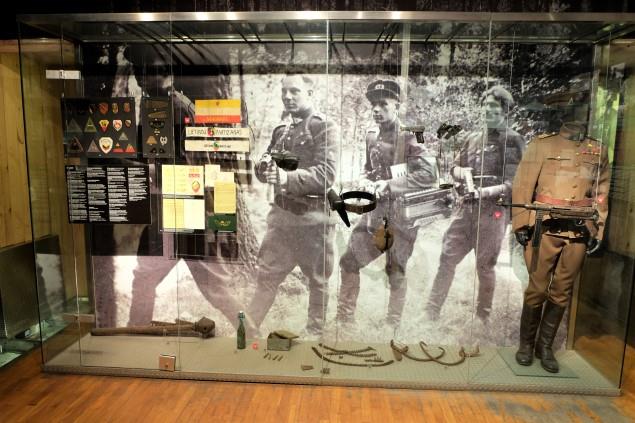Soviet Union, KGB, Nazis, Genocide…Which country comes to mind first when we hear these words? Probably not Lithuania for most of us. The knowledge of Lithuanian history for many of us may also be limited by the fact that it was part of the Union of Soviet Socialist Republics until recently.. Truthfully, not much is known about Lithuania in Turkey and until we went to Vilnius when the country was part of the Soviet Union, 2. We could not fully grasp what he went through during World War II and the Nazi occupation, and what kind of effects these processes had.. Until I set foot in the Museum of Genocide Victims, or the Museum of Genocide Victims, in other words the KGB Museum, located in the former KGB building.. Or we can say until the following data hits us:
During the 50-year (1940-1991) Soviet Socialist Republics Union rule in Lithuania:
Number of people arrested, questioned and imprisoned: ~200,000
Number of people deported: ~132,000
Number of detainees: ~20,000-25,000
Number of people who died in exile : ~28,000
Number of dead Lithuanian guerrillas and their supporters: ~21,500
Lithuania was under Nazi occupation for 3 years (1941-1944) period:
Number of people arrested and sent to concentration camps: ~29,500
Number of people killed (together with around 200,000 Jews): ~240,000
Number of people exiled to Germany for forced labor: ~60,000
The naming of the museum as “Victims of the Holocaust” has nothing to do with the Jewish Holocaust in the country alone.. In fact, the museum is largely dedicated to informing about 50 years of USSR domination in Lithuania, Lithuanian resistance to the Soviets, human rights violations, executions and arrests during this period.. At this point, a short history lesson may not do any harm, because we will touch on a long 50-year period that Lithuania lived between 1940-1991.. Don’t worry, it will be a short and clear summary.. Lithuania came under the rule of the USSR in 1940.. It is occupied by Nazi Germany in 1941, but the USSR begins to rule again, taking Lithuania from the Germans in 1944.. From 1944 to 1953, the Soviets engage in serious warfare with pro-independence Lithuanian guerrillas. Thousands of people are killed, arrested, deported, sent to labor camps. From 1954 to 1991, citizens struggled for their independence with the “Anti-Soviet Resistance” and Lithuania officially gained its independence in 1991.
All practices of the Soviet regime in Lithuania during this period, which lasted for 50 years in total. It takes place in the KGB building, where the museum is located.. That is, in the building that used to be the USSR’s intelligence and secret service and its prison.. Many of the arrests, tortures and executions we mentioned above take place here.. The KGB building and prison were also used by Nazi Germany in 1941-1944, that is, during the Nazi occupation of Vilnius.. So as you can see, most of the things you will see and read in this museum will darken your heart and shake your body.
We decide to go to the museum on a rainy and gloomy day after 3 consecutive sunny days.. From the outside it looks like a building that resembles other buildings in the city; a huge, Soviet-era building. Dozens of names are written on its wall, with dates of birth and death.. We get hung up on how young so many die, people 19-20. We realize that there are people who have died inside the building we are going to visit shortly.. When we enter the museum, we try to get our tickets from the employee who does not speak a word of English and is dedicated to ruining the visitors’ day.. It’s like this museum is trying to test our psychology at that moment, which we haven’t actually seen yet.. Since we have limited time, another (sweet) museum employee tells us, “Go down to the first basement, it will be of interest to you”, and we head downstairs without being too aware of what we are doing.. When the number of windows and daylight begin to decrease and the environment becomes gloomy, we realize that this is a prison.
PS. The prison, which we visited and you can see in the photos below, remains mostly as KGB officers left when Lithuania gained its independence from the USSR in 1991.
The ones brought to the KGB prison were first brought to this small, 0.6 It was placed in cells of m2. He was kept here for hours until the officers processed their documents.. In the first periods of the prison, the detainees had to wait standing, but after the oppression eased with the death of Stalin, a space was made for them to sit in the cells.
Here photographs are taken, fingerprints are taken, and records are completed.
The bags you see in this room contain documents that KGB officers tore up in 1988-1991.. During the Soviet period, they tried to hide many documents by burning, shredding or taking them to Russia so that their actions could not be traced.. Some documents found, criminal records are currently kept in Lithuania’s private archive.
Prison guards’ room. Here they were resting and taking classes on political issues.. According to the 1950 employee list, there were 73 people working in the prison.. The number was insufficient compared to this prison, but it was difficult to find people to work here.
One of the most frightening places in the prison; cell with soundproofing. The jacket inside the room was used for those who resisted torture.. Soundproofed throughout the room so that screams are not heard.. According to the prison records, there used to be 5 rooms like this.. Some tortured people here have personally verified this data.. Torture was officially banned in 1953 with the death of Stalin, but drugs, threats, blackmail and some provocation methods continued to be used to interrogate the criminals.
In the early periods, detainees were only allowed to take a shower once a month. given. The guards would turn the water on and off, and sometimes they would suddenly turn on cold or hot water just for “fun”.. They were allowed to use the toilets once a day, and they had to fill their needs in a bucket for the rest of the day.
They identified some methods to discipline the prisoners.. The prisoners had to balance on this round platform, those who lost their balance would fall into the ice-cold water (we’re talking about really ice-filled water) and they had to wait like that..
execution chamber. More than 1000 people were killed here in the period from 1944 to the early 60s.. At least 1/3 were sentenced to death by a Soviet court for their participation in the Anti-Soviet resistance. There is no record of how these people were executed, they were managed by a top secret team.. It is known that 767 people who were shot were thrown into a mass cemetery at a point in the middle of the city.. During the archaeological excavations carried out in 1994, 1996 and 2003, 724 of these people were unearthed and buried at another point.. There are no records of where those executed after 1950 are buried, but it is believed that there may be several mass graves near Vilnius.. Under the glass on the floor of the room, there are some belongings of the people who were executed.
According to official records, the prison was suitable for 675 prisoners in 1940 and 3250 in 1945.. In January 1945, there were 8786 prisoners in total in the prison.. Sometimes 15-20 people had to stay in the cells at the same time.. Moreover, until 1947, there was nothing in the cells.. They had to sleep in their clothes only in cement places, and the lights were on all the time, morning and evening.. Solitary cells were used for those who broke prison rules.. In these cells, the prisoners were trying to survive for 10 days, naked without any heating, with 5 hours of sleep and only half a liter of warm water and 300 grams of bread a day. dedicated to the invasion and genocide. Here there is an exhibition with articles, images and explanations about the genocide of the people who were victims of this occupation.. As we mentioned above, the KGB building and prison were also used by the German authorities (Gestapo) during the Nazi occupation of Lithuania in 1941-1944.. Outside of the prison, the Nazis deported Jews to 12 “ghettos” they formed throughout Lithuania within 3 years, killed approximately 240,000 people, including Lithuanians, Russians, and Belarusians who opposed the Nazi regime, and sent 60,000 people to Germany for labour.
There is a very detailed exhibition area on the ground floor and upper floor of the museum about the history of Lithuania and what it went through during these processes.. This room, located on the upper floor, is the room where the KGB “overhears”, that is, where people listen to their private conversations.. The majority of this floor is reserved for the technical unit of the KGB, that is, for the people who listen to it.. Some of the equipment used is still in this room.
*Here we have a detailed travel guide with lots of information about Vilnius. We also have some articles about Trakai, the place where Karay Turks live, located near Vilnius, and the Republic of Uzupis, which is a very interesting formation.







